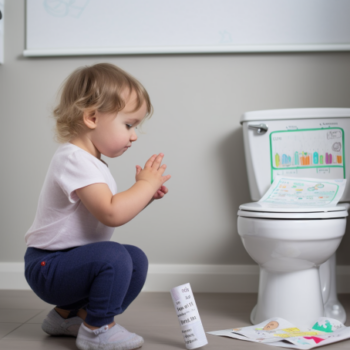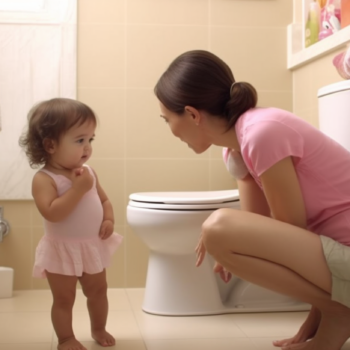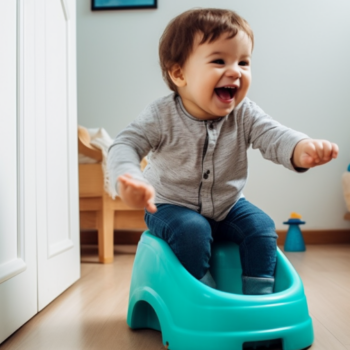If you're in the midst of potty training your little one, you may be wondering if a step stool is necessary. The answer is yes! A step stool can make the potty training process much easier for both you and your child. It allows them to easily climb up to the toilet and sit comfortably, increasing their sense of independence and reducing the likelihood of accidents. Additionally, a step stool can help prevent strain and discomfort for your child's legs and feet while they sit on the toilet. Overall, investing in a step stool is a simple and effective way to make potty training a smoother and more successful experience.
Tag: potty training
Top Potty Training Products for Girls: A Guide to Keep Your Little One Dry and Clean.
Potty training can be a challenging time for both parents and children, but having the right products can make all the difference. If you're potty training a girl, there are a variety of helpful products available to make the process easier. Potty chairs designed specifically for girls, like those with a splash guard or anatomical shape, can make sitting on the potty more comfortable. Training pants that are absorbent but also allow for easy movement can help prevent accidents while still providing a sense of independence. And don't forget about rewards like stickers or a special potty-themed book to motivate your little one. With the right tools, potty training can be a more positive experience for everyone involved.
Effective Strategies for Encouraging Girls during Potty Training
Potty training can be a challenging journey for parents, especially when it comes to encouraging girls. One of the best ways to encourage girls during potty training is to make it fun and rewarding. Use stickers, charts, and treats to incentivize and celebrate successes, and avoid punishment or negative reinforcement. Be patient and responsive to your child's needs and schedule, and try to make potty training a positive experience. Demonstrate how to use the potty yourself, and encourage your child to practice regularly. With the right approach and attitude, potty training can be a successful and rewarding experience for both parents and kids.
Expert Tips for Dealing with Potty Training Accidents in Girls
Potty training can be a challenging time for parents and accidents are a common occurrence. When it comes to potty training girls, accidents can happen for a variety of reasons, including physical and emotional factors. It's important to handle accidents with patience, understanding, and a positive attitude. In this blog post, we'll share tips and strategies for dealing with accidents during potty training for girls. From creating a supportive environment to using positive reinforcement, we'll cover everything you need to know to make potty training a success for your little girl.
Potty Training: Choosing Between Rewards and Incentives for Your Son’s Success
Potty training is a significant milestone in a child's development, but it can be challenging for parents. One common dilemma is whether to use rewards or incentives. While both can be effective, it's essential to choose the right approach that suits your child's personality and behavior. Rewards, such as stickers or treats, can be motivating for some children, while others may respond better to incentives, such as screen time or a special outing. Whichever approach you choose, consistency and positive reinforcement are key to successful potty training. Remember to celebrate every small achievement and be patient with your child's progress. With the right approach, potty training can be a rewarding and positive experience for both you and your child.
7 Common Potty Training Mistakes Every Parent Must Avoid
When it comes to potty training, there are a few common mistakes that many parents make. Firstly, starting too early can lead to frustration and setbacks. Secondly, inconsistent or vague instructions can confuse your child. Thirdly, using punishment instead of positive reinforcement can create anxiety and negative associations. Lastly, not being prepared for accidents and not having a plan for nighttime training can lead to stress for both parents and children. By avoiding these common mistakes, you can help ensure a smoother and more successful potty training experience for your child.
Knowing the Right Time to Stop Using Diapers with Your Child – All You Need to Know
As a parent, it can be difficult to know when it's time to transition your child out of diapers. While every child is different, there are certain signs that indicate they may be ready to start using the toilet. These include being able to communicate their needs, having longer periods of dryness, and showing an interest in the toilet. It's important to remember that potty training is a process and may take some time. It's also important to be patient and supportive during this transition. By following your child's cues and offering encouragement, you can help them successfully make the move from diapers to the toilet.
Potty Training Timeline: How Long Does It Take to Successfully Train a Child?
Potty training is a significant milestone for both parents and children. However, the duration of the process varies for different children. Some may take a few days, while others may need several months or even longer. Factors such as age, temperament, and readiness play a crucial role in determining how long it takes to potty train a child. Nevertheless, it is important to be patient and consistent in the process, as pushing a child too hard or rushing them can lead to regression. With the right approach, encouragement, and rewards, most children can successfully transition from diapers to using the toilet in due time.
A Comprehensive Guide to Determine Your Child’s Potty Training Readiness
Potty training is an important milestone in a child's development, but it can be challenging for both the child and parent. It's important to know if your child is ready before starting the process. Some signs that your child may be ready include showing interest in the potty, being able to stay dry for a few hours, and being able to communicate their needs effectively. It's important to be patient and positive during the process, as every child is different and may take longer to master this skill. By following your child's cues and providing plenty of encouragement and support, you can help them successfully navigate this important stage in their development.
When to Begin Potty Training: A Parent’s Guide to Knowing the Perfect Age
Potty training can be a daunting task for parents, but it's an important milestone for your child's development. The question of what age to start potty training is common among parents, and the answer may vary based on your child's readiness. However, experts suggest that children can start potty training as early as 18 months old. It's important to look for signs of readiness, such as showing an interest in using the toilet and pulling down their own pants. Starting the process early can also prevent regression and make the transition smoother. Remember, every child is different, and there's no one-size-fits-all approach to potty training. Just be patient, consistent, and positive throughout the journey.



